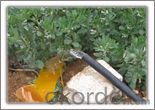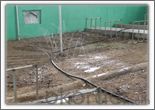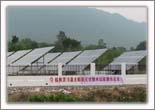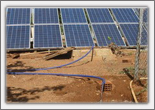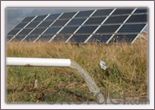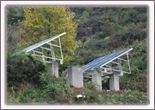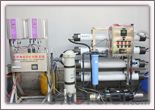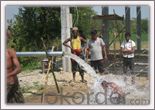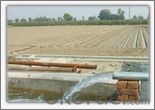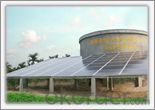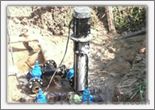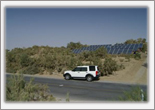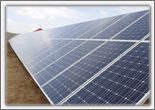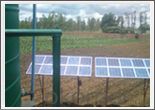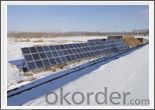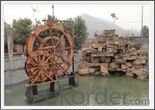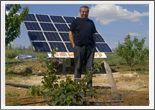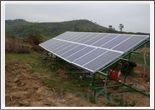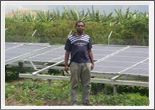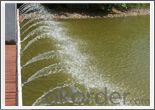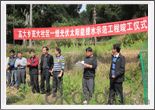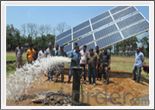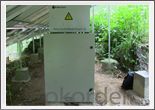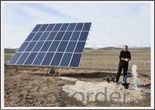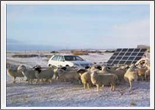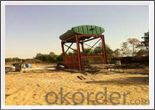Solar Pumping Inverter for Solar Water Pumping System
- Loading Port:
- Shekou
- Payment Terms:
- TT or LC
- Min Order Qty:
- 20 unit
- Supply Capability:
- 800000 unit/month
OKorder Service Pledge
OKorder Financial Service
You Might Also Like
Products
Solar Inverter Introduction:
Solar pumping inverter converts DC current from the solar array into AC current to drive the pump. With the function of MPPT (maximum power point tracking), it regulates the output frequency according to irradiation in real time to achieve the maximum power.
Solar Inverters Features:
1. Adopting the proposed dynamic VI maximum power point tracking (MPPT) control method; Fast response and stable operation; Better than the conventional methods which may lead to the problems including poor tracking performances, unstable or even cause water hammer damaging when the irradiation on the array changes rapidly.
2. The solar pumping inverters system is dispensed with energy storing devices, and stores water instead of electricity. It improves the reliability of the device, at the same time, it lowers the construction and maintenance costs of the system dramatically.
3. Digital control; automatic operation and data acquisition/storage of 8 years, etc; 98% of conversion efficiency, and complete protection.
4. In-line blocks; user friendly; convenient for operating; perfect cooling and shielding.
Technical Features
Solar Pumping Inverter Advantages:
1. To drive pumps equipped with 3-phase induction motors.
2. Optimized SPWM.
3. Various operation modes and MPPT algorithms are available.
4. Adjustable speed range of pump based on the actual situation of the system.
5. Available option of water-level detecting and control circuit.
6. Protection functions: lightning, over/low input voltage, over current and over load protection, etc.
7. Enclosure class: IP52.
8. Ambient temperature:-10~+50˚C.
Poduct Specifications
Model | Maximum input dc voltage | Recommended MPP Voltage | Rated Output Current | Output Voltage | Output Frequency | Net Weight | Gross Weight | Package Size | ||
Length | Width | Height | ||||||||
PB400L | 450 | 280-350 | 3 | 3PH 220V | 0-50 | 3.4 | 4.9 | 320 | 280 | 225 |
PB750L | 450 | 280-350 | 5 | 3PH 220V | 0-50 | 3.4 | 4.9 | 320 | 280 | 225 |
PF750L | 450 | 150-350 | 5 | 3PH 220V | 0-60 | 6.1 | 7.1 | 425 | 325 | 250 |
PB1500L | 450 | 280-350 | 7 | 3PH 220V | 0-50 | 4.0 | 5.6 | 355 | 280 | 225 |
PF1500L | 450 | 150-350 | 7 | 3PH 220V | 0-60 | 7.5 | 8.5 | 425 | 325 | 285 |
PB2200L | 450 | 280-350 | 11 | 3PH 220V | 0-50 | 4.0 | 5.6 | 355 | 280 | 225 |
PF2200L | 450 | 150-350 | 11 | 3PH 220V | 0-60 | 7.9 | 9.0 | 425 | 325 | 285 |
PB3700LA | 450 | 280-350 | 17 | 3PH 220V | 0-50 | 7.2 | 9.5 | 425 | 325 | 285 |
PB5500LA | 450 | 280-350 | 25 | 3PH 220V | 0-50 | 7.3 | 9.6 | 425 | 325 | 285 |
PB3700H | 750 | 500-600 | 9 | 3PH 380V | 0-50 | 7.2 | 9.5 | 425 | 325 | 285 |
PB5500H | 750 | 500-600 | 13 | 3PH 380V | 0-50 | 7.3 | 9.6 | 425 | 325 | 285 |
PB7500H | 750 | 500-600 | 18 | 3PH 380V | 0-50 | 7.7 | 10 | 425 | 325 | 285 |
PB11KH | 750 | 500-600 | 24 | 3PH 380V | 0-50 | 8.2 | 10.5 | 425 | 325 | 285 |
PB15KH | 750 | 500-600 | 30 | 3PH 380V | 0-50 | 8.4 | 10.7 | 425 | 325 | 285 |
PB18KH | 750 | 500-600 | 39 | 3PH 380V | 0-50 | 8.4 | 10.7 | 425 | 325 | 285 |
PB22KH | 750 | 500-600 | 45 | 3PH 380V | 0-50 | 18 | 21 | 600 | 465 | 350 |
PB30KH | 750 | 500-600 | 60 | 3PH 380V | 0-50 | 18 | 21 | 600 | 465 | 350 |
PB37KH | 750 | 500-600 | 75 | 3PH 380V | 0-50 | 20 | 23 | 600 | 465 | 350 |
PB45KH | 750 | 500-600 | 91 | 3PH 380V | 0-50 | 20 | 23 | 600 | 465 | 350 |
PB55KH | 750 | 500-600 | 112 | 3PH 380V | 0-50 | 20 | 23 | 600 | 465 | 350 |
Success Stories
►Middle East ►NaQu ►GuiLin
►Turkey ►XiNing ►YunNan
►Army stationed island ►Bangladesh ►Pakistan
►HaiNan ►HuBei ►Uganda
►XinJiang ►NingXia ►Afghan
►Zimbabwe ►Inner Mongolia ►Zhejiang
►Guangxi Guilin ►Turkey2 ►Botswana
►Naning ►Uganda ►Shaanxi
►Tsinghua University ►Pakistan ►Yunnan2
►FuJian ►Banqladesh ►YunNan3
►Turkey ►Inner Mongolia ►Senegal
- Q:Can a solar energy system be connected to the grid?
- Yes, a solar energy system can be connected to the grid. In fact, most solar installations are designed to be grid-connected, allowing excess electricity to be fed back into the grid and reducing reliance on non-renewable energy sources. This connection also enables homeowners and businesses to benefit from net metering programs, where they receive credits or payments for the surplus electricity they generate.
- Q:What is the lifespan of solar panels used in solar energy systems?
- The lifespan of solar panels used in solar energy systems typically ranges from 25 to 30 years, although some panels can last even longer with proper maintenance and care.
- Q:Can solar energy systems be used for powering electric vehicles?
- Yes, solar energy systems can be used to power electric vehicles. Solar panels can generate electricity from sunlight, which can then be stored in batteries or directly used to charge the vehicle's battery pack. This allows for a clean and renewable source of energy to power electric vehicles, reducing reliance on fossil fuels and decreasing greenhouse gas emissions.
- Q:Can a solar energy system be installed on a ground mount?
- Yes, a solar energy system can be installed on a ground mount. Ground-mounted solar systems are a popular choice for homeowners or businesses who have ample space on their property. By installing solar panels on a ground mount, they can be positioned at the optimal angle for capturing sunlight, maximizing energy production. Ground mounts also offer flexibility in terms of system size and orientation, making them suitable for various locations and terrains.
- Q:Can solar energy systems be installed on parking lots or carports?
- Yes, solar energy systems can be installed on parking lots or carports. In fact, these locations offer ample space for solar panel installations, allowing for the generation of clean and renewable energy while also providing shade for parked vehicles. This dual-purpose use of space is increasingly popular and beneficial in terms of reducing carbon emissions and utilizing underutilized areas for sustainable energy production.
- Q:Are there any environmental impacts associated with solar energy systems?
- Yes, there are some environmental impacts associated with solar energy systems, although they are generally considered to be significantly less harmful than those associated with traditional energy sources. The production and disposal of solar panels can result in the release of greenhouse gases and other pollutants, especially when not properly managed. Additionally, the mining and extraction of raw materials used in solar panels, such as silicon, can have negative environmental consequences. However, these impacts are relatively minor compared to the emissions and pollution caused by fossil fuel-based energy generation. Furthermore, solar energy systems do not produce air or water pollution during operation and do not contribute to climate change. Overall, while there are some environmental impacts associated with solar energy systems, they are far outweighed by the long-term benefits of reducing greenhouse gas emissions and transitioning to clean and renewable energy sources.
- Q:Can solar energy systems be used to power boats or yachts?
- Indeed, boats or yachts can utilize solar energy systems for their power needs. By installing solar panels on the boat's roof or deck, sunlight can be captured and converted into electricity. This electrical energy can then be utilized to operate various systems onboard, including lighting, navigation equipment, communication devices, refrigeration, and even propulsion systems. The size and capacity of the solar energy system will be determined by the boat or yacht's specific power requirements and the available installation space. Opting for solar-powered boats and yachts offers numerous advantages, including decreased reliance on fossil fuels, lowered operational expenses, quieter operation, and reduced carbon emissions. However, it is important to acknowledge that solar energy alone may not suffice for larger vessels or extended periods of low sunlight. In such instances, a hybrid system that combines solar energy with alternative power sources, like wind or diesel generators, may be more suitable.
- Q:Can solar energy systems be used in powering amusement arcades or gaming centers?
- Yes, solar energy systems can be used to power amusement arcades or gaming centers. Solar panels can be installed on the roof or in nearby open spaces to harness sunlight and convert it into electricity. This renewable energy can then be used to power the electrical equipment, lighting, and other energy-consuming devices within the amusement arcade or gaming center. Implementing solar energy systems not only reduces reliance on traditional energy sources but also saves costs in the long run and promotes sustainable practices.
- Q:How do solar energy systems affect the resale value of homes?
- Solar energy systems can have a positive impact on the resale value of homes. Studies have shown that homes equipped with solar panels tend to sell for a higher price compared to similar homes without solar systems. This increase in value is primarily due to the potential energy cost savings and the growing demand for sustainable solutions among homebuyers. Additionally, solar energy systems often come with attractive incentives and tax credits, making them an appealing feature for potential buyers.
- Q:How do solar energy systems affect water usage?
- Solar energy systems can have a positive impact on water usage as they do not require water to generate electricity, unlike conventional power plants. This means that solar energy systems can help conserve water resources, especially in areas where water scarcity is a concern.
1. Manufacturer Overview |
|
|---|---|
| Location | |
| Year Established | |
| Annual Output Value | |
| Main Markets | |
| Company Certifications | |
2. Manufacturer Certificates |
|
|---|---|
| a) Certification Name | |
| Range | |
| Reference | |
| Validity Period | |
3. Manufacturer Capability |
|
|---|---|
| a)Trade Capacity | |
| Nearest Port | |
| Export Percentage | |
| No.of Employees in Trade Department | |
| Language Spoken: | |
| b)Factory Information | |
| Factory Size: | |
| No. of Production Lines | |
| Contract Manufacturing | |
| Product Price Range | |
Send your message to us
Solar Pumping Inverter for Solar Water Pumping System
- Loading Port:
- Shekou
- Payment Terms:
- TT or LC
- Min Order Qty:
- 20 unit
- Supply Capability:
- 800000 unit/month
OKorder Service Pledge
OKorder Financial Service
Similar products
New products
Hot products
Hot Searches
Related keywords















